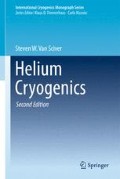Abstract
A system of non-interacting particles obeying quantum statistics is considered to be an ideal quantum gas. There are a number of physical systems in nature that display quantum gas behavior. Common examples include the behavior of electrons and phonons in solids. Also, low density gas molecules at low temperatures can show quantum mechanical behavior as we discussed in Chap. 3. Of most recent interest are gases made up of Rb or H atoms that undergo Bose-Einstein condensation.
Access this chapter
Tax calculation will be finalised at checkout
Purchases are for personal use only
References
L. D. Landau and E. M. Lifshitz, Statistical Physics, Addison-Wesley, Reading, MA, 1969.
K. Huang, Statistical Mechanics, Wiley, New York, 1963.
Data from HEPAK®.
F. London, Superfluids, Vol. II, Dover Publications, New York, 1954.
L. Tisza, The λ-Transition Explained. Nature, Vol. 141, p 913 (1938).
C. J. Gorter and H. Cashmir, Physica 1, 305 (1934) or see F. London, Superfluids Vol. 1, Dover, NY, 1960, pp. 15–19.
L. Landau, Theory of the Superfluidity of Helium II. Phys. Rev., Vol. 60, No. 4, 356 (1941).
J. Wilks, Liquid and Solid Helium, Clarendon Press, Oxford, 1967.
J. Maynard, Determination of the Thermodynamics of He II from Second Sound Data, Phys. Rev. B14, 3868 (1976).
V. Peshkov, Determination of the Velocity of Propagation of the Second Sound in He II, J. Phys. (USSR) 10, 389 (1946).
R. J. Donnelly, The Two-Fluid Theory and Second Sound in Liquid Helium, Phys. Today Vol. 62, 34 (2009).
E. L. Andronikashvili, Zh. Esksp. Theor. Fiz. 16, 780 (1946); 18, 424 (1948).
D. V. Osborne, The Rotation of Liquid Helium II, Proc. Phys. Soc. A63, 909 (1950).
G. A. Williams and R. E. Packard, Photographs of Quantized Vortex Lines in Rotating He II, Phys. Rev. Lett. 33, 280 (1974); E. A. Yarmchuk and R. E. Packard, Photographic Studies of Quantized Vortex Lines, J. Low Temp. Phys. 46, 479 (1982).
G. P. Bewley, D. P. Lathrop, K. Sreenivasan, Superfluid Helium: Visualization of quantized vortices, Nature 441, 558 (2006).
R. P. Feynmann, Application of Quantum Mechanics to Liquid Helium, in Progress in Low Temperature Physics, C. J. Gorter (Ed.), Vol. I, p. 17, North Holland Publishing, Amsterdam, 1955.
C. J. Gorter and J. H. Mellink, On the Irreversible Processes in Liquid Helium II, Physica XV, 285 (1949).
T. Chagovets and S. W. Van Sciver, A Study of Thermal Counterflow using PTV, Phys. Fluids, Vol. 23, 107102 (2011).
W. F. Vinen, Theory of the Mutual Friction, Proc. R. Soc. (London) A242, 493 (1957).
J. T. Tough, Superfluid Turbulence, in Progress in Low Temperature Physics, D. F. Brewer (Ed.), Vol. VIII, Chap. 3, North Holland Publishing, Amsterdam, 1982.
K. W. Schwarz, Turbulence in Superfluid Helium: Steady Homogeneous Counterflow, Phys. Rev. 18, 245 (1978).
V. Arp, Heat Transport through Helium II, Cryogenics 10, 96 (1970).
W. F. Vinen, Experiments on Steady Heat Currents, Proc. R. Soc. London A240, 114 (1957).
S. W. Van Sciver, Kapitza Conductance of Aluminum and Heat Transport Through Subcooled He II, Cryogenics 18, 521 (1978).
D. F. Brewer and D. O. Edwards, Heat Conduction by Liquid Helium II in Capillary Tubes. III. Mutual Friction, Philos. Mag. 7, 721 (1962).
W. F. Vinen, Critical Heat Currents in Wide Channels, Proc. R. Soc. London A243, 400 (1957).
W. F. Vinen, Experiments on Transient Effects, Proc. R. Soc. London A240, 128 (1957).
C. E. Chase, Thermal Conduction in Liquid Helium II. I. Temperature Dependence Effects of Channel Geometry, Phys. Rev. 127, 361 (1962); Thermal Conduction in Liquid Helium II. Phys. Rev. 131, 1898 (1963).
T. N. Turner, Using Second Sound Shock Waves to Probe the Intrinsic Critical Velocity of Liquid Helium II, Phys. Fluids Vol. 26, 3227 (1983).
J. R. Torczynski, On the Interaction of Second Sound Shock Waves and Vorticity in Superfluid Helium, Phys. Fluids Vol. 27, 2636 (1984).
T. Shimazaki, M. Murakami, and T. Iida Second Sound Wave Heat Transfer, Thermal Boundary Layer Formation and Boiling: Highly Transient Heat Transport Phenomena in He II, Cryogenics Vol. 35, 645 (1995).
D. K. Hilton and S. W. Van Sciver, Direct Measurements of Quantum Turbulence Induced by Second Sound Shock Pulses in Helium II, J. Low Temp. Phys. Vol . 141, 501 (2005).
Further Readings
K. R. Atkins, Liquid Helium, Cambridge University Press, Cambridge, 1959.
T. Guenault, Basic Superfluids, Taylor Francis, London, 2003.
K. Huang, Statistical Mechanics, Wiley, New York, 1963.
W. E. Keller, Helium-3 and Helium-4, Plenum Press, New York, 1969.
L. D. Landau and E. M. Lifshitz, Statistical Physics, Addison-Wesley, Reading, MA, 1969.
F. London, Superfluids, Vol. II, Dover Publications, New York, 1954.
S.J. Putterman, Superfluid Hydrodynamics, Elsvier, Amsterdam, 1974.
D. R. Tilley and J. Tilley, Superfluidity and Superconductivity, Adan Hilger, Boston, 1986.
J. Wilks, Liquid and Solid Helium, Clarendon Press, Oxford, 1967.
Author information
Authors and Affiliations
Corresponding author
Rights and permissions
Copyright information
© 2012 Springer Science+Business Media, LLC
About this chapter
Cite this chapter
Van Sciver, S.W. (2012). Helium as a Quantum Fluid. In: Helium Cryogenics. International Cryogenics Monograph Series. Springer, New York, NY. https://doi.org/10.1007/978-1-4419-9979-5_6
Download citation
DOI: https://doi.org/10.1007/978-1-4419-9979-5_6
Published:
Publisher Name: Springer, New York, NY
Print ISBN: 978-1-4419-9978-8
Online ISBN: 978-1-4419-9979-5
eBook Packages: Physics and AstronomyPhysics and Astronomy (R0)

